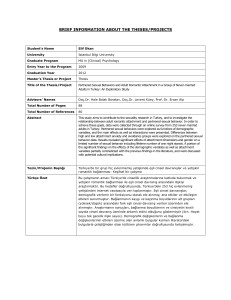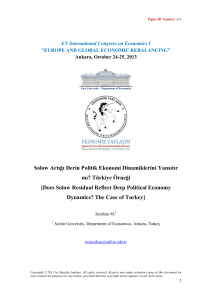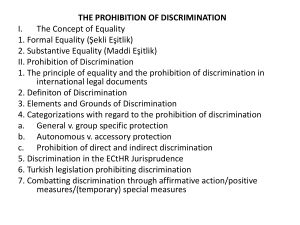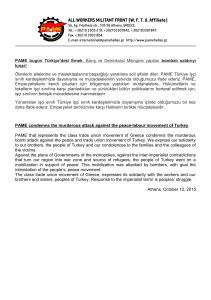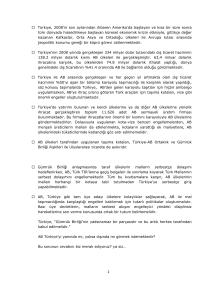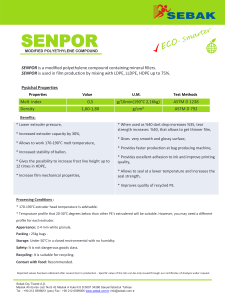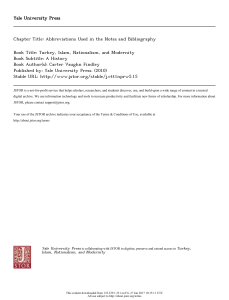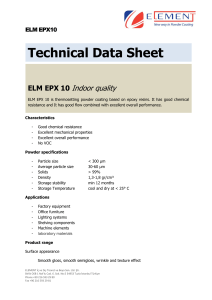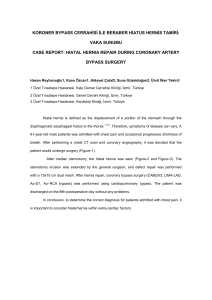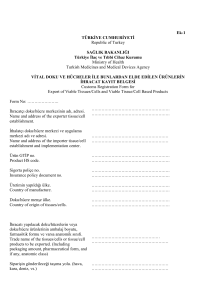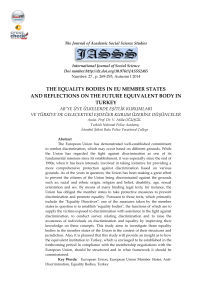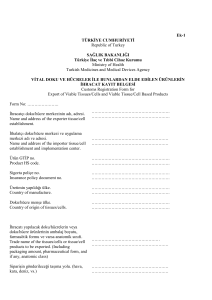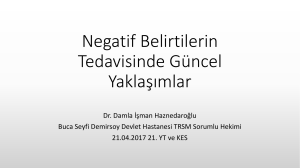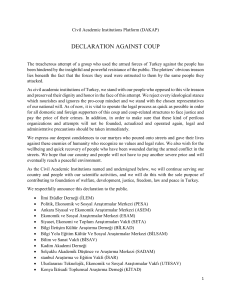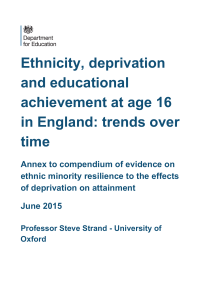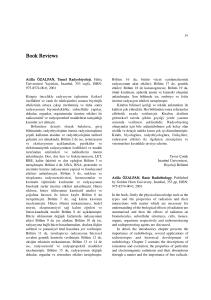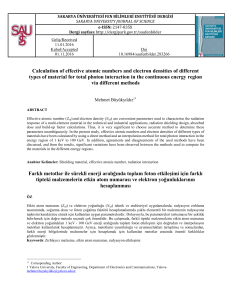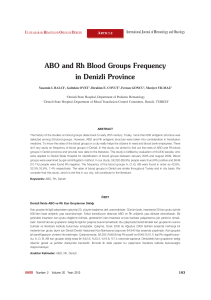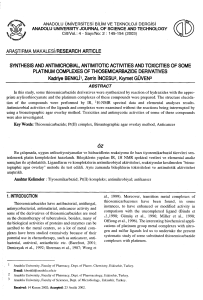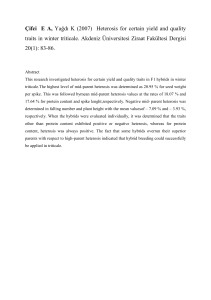Algılanmış Etnik Ayrımcılık Deneyimleri ile Türkiye`de
advertisement
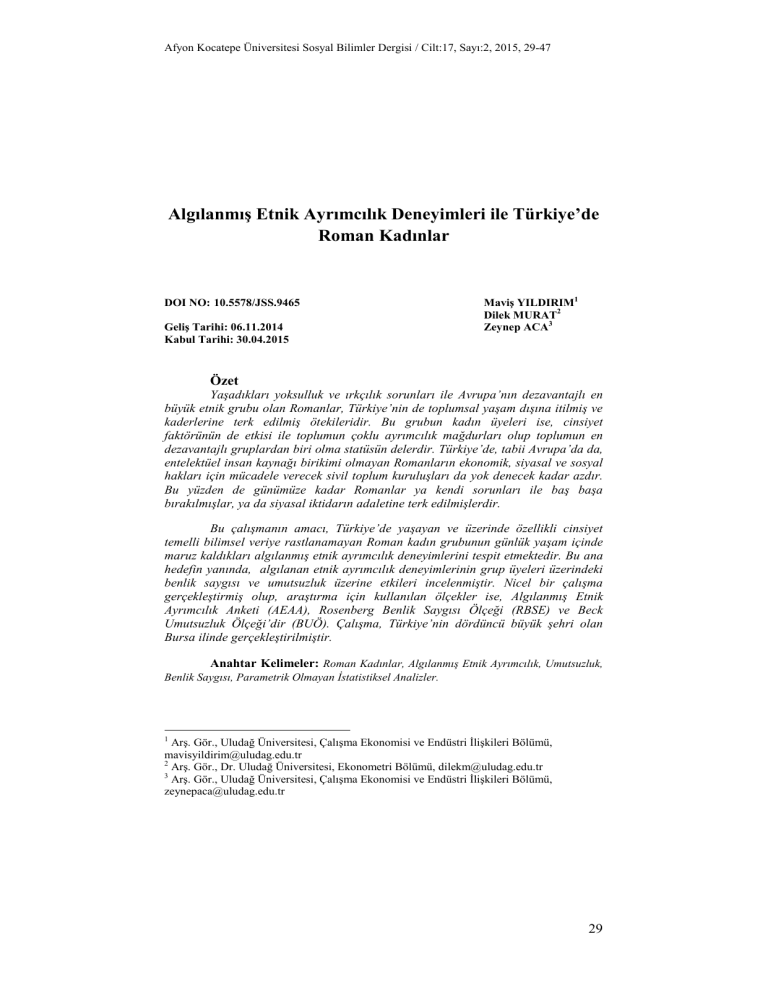
Afyon Kocatepe Üniversitesi Sosyal Bilimler Dergisi / Cilt:17, Sayı:2, 2015, 29-47 Algılanmış Etnik Ayrımcılık Deneyimleri ile Türkiye’de Roman Kadınlar DOI NO: 10.5578/JSS.9465 Geliş Tarihi: 06.11.2014 Kabul Tarihi: 30.04.2015 Maviş YILDIRIM1 Dilek MURAT2 Zeynep ACA3 Özet Yaşadıkları yoksulluk ve ırkçılık sorunları ile Avrupa’nın dezavantajlı en büyük etnik grubu olan Romanlar, Türkiye’nin de toplumsal yaşam dışına itilmiş ve kaderlerine terk edilmiş ötekileridir. Bu grubun kadın üyeleri ise, cinsiyet faktörünün de etkisi ile toplumun çoklu ayrımcılık mağdurları olup toplumun en dezavantajlı gruplardan biri olma statüsün delerdir. Türkiye’de, tabii Avrupa’da da, entelektüel insan kaynağı birikimi olmayan Romanların ekonomik, siyasal ve sosyal hakları için mücadele verecek sivil toplum kuruluşları da yok denecek kadar azdır. Bu yüzden de günümüze kadar Romanlar ya kendi sorunları ile baş başa bırakılmışlar, ya da siyasal iktidarın adaletine terk edilmişlerdir. Bu çalışmanın amacı, Türkiye’de yaşayan ve üzerinde özellikli cinsiyet temelli bilimsel veriye rastlanamayan Roman kadın grubunun günlük yaşam içinde maruz kaldıkları algılanmış etnik ayrımcılık deneyimlerini tespit etmektedir. Bu ana hedefin yanında, algılanan etnik ayrımcılık deneyimlerinin grup üyeleri üzerindeki benlik saygısı ve umutsuzluk üzerine etkileri incelenmiştir. Nicel bir çalışma gerçekleştirmiş olup, araştırma için kullanılan ölçekler ise, Algılanmış Etnik Ayrımcılık Anketi (AEAA), Rosenberg Benlik Saygısı Ölçeği (RBSE) ve Beck Umutsuzluk Ölçeği’dir (BUÖ). Çalışma, Türkiye’nin dördüncü büyük şehri olan Bursa ilinde gerçekleştirilmiştir. Anahtar Kelimeler: Roman Kadınlar, Algılanmış Etnik Ayrımcılık, Umutsuzluk, Benlik Saygısı, Parametrik Olmayan İstatistiksel Analizler. 1 Arş. Gör., Uludağ Üniversitesi, Çalışma Ekonomisi ve Endüstri İlişkileri Bölümü, mavisyildirim@uludag.edu.tr 2 Arş. Gör., Dr. Uludağ Üniversitesi, Ekonometri Bölümü, dilekm@uludag.edu.tr 3 Arş. Gör., Uludağ Üniversitesi, Çalışma Ekonomisi ve Endüstri İlişkileri Bölümü, zeynepaca@uludag.edu.tr 29 M. Yıldırım vd . / Algılanmış Etnik Ayrımcılık Deneyimleri ile Türkiye’de Roman Kadınlar Perceived Ethnic Discrimination Experiences of Romani Women in Turkey Abstract The biggest and most problematic ethnic group suffering from poverty and racism in Europe, the Romani people are “the others” who have been marginalized and left to their fate also in Turkey. The women members of this group are more vulnerable to multiple discrimination and thus, constitute the one of the most disadvantaged group of the society. The Romani people have almost no intellectual accumulation in Turkey or in Europe. They have almost no non-governmental organizations to fight for their economic, political and social rights, either. Therefore, until recently they have been either left alone to solve their problems on their own or abandoned to the justice of political power. The purpose of this study is to detect the perceived ethnic discrimination experiences of Romani women who live in Turkey but about whom there are no scientific data. In addition to this, the study also examines the effects of perceived discrimination experiences on group members’ self-esteem and hopelessness. The scales used to collect quantitative data are The Perceived Ethnic Discrimination Questionnaire, Rosenberg Self-Esteem Scale and Beck Hopelessness Scale. The study was conducted in Bursa, the fourth biggest city in Turkey. Keywords: Romani Women, Perceived Ethnic Hopelessness, Self-esteem, Non-parametric Statistical Analysis. Discrimination, 1. Introduction In social life every single individual can be a victim of discrimination; however, minority group members, because of their “different features”, are more likely to be subject to discrimination (Dovidio ve Hebl, 2005: 11). Thus, the social policies that are expected for the minority groups are undoubtedly essential (Altan, 2007: 5-6). Individuals and groups can be subject to discrimination at many levels: “cultural, social, institutional and individual” (Dovidio ve Hebl, 2005: 11). The Romanis are one of the primary disadvantaged groups who discriminated in the societies they have lived from past to today. Their different life styles, clothes, lack of education, lack of second language, as well as racism and poverty they have encountered as a result of their weak socioeconomic situation have caused them to work as “others” in unqualified jobs in labour market. In other words, they constitute an ethnic group excluded from social processes (Kolukırık, 2006; Kurt-Topuz, 2010; Öke and Kurt-Topuz, 2010; Roman Topluluklar İçin Bütünlüklü Sosyal Politikalar Geliştirme Projesi, 2011). Romanis approximately between 7-10 per cent of the total population in Bulgaria, Slovakia, Romania, Serbia and Hungary but Turkey 30 Afyon Kocatepe Üniversitesi Sosyal Bilimler Dergisi / Cilt:17, Sayı:2, 2015, 29-47 has biggest Romani population in Europe. According to the data in EU Framework for National Roma Integration Strategies up to 2020 (2011:1518), there are 2.750.000 Romanis in Turkey. Turkey is followed by Romania with 1.850.000, Bulgaria with 750.000 and Hungary with 700.000 Romanis. There is no scientific research on specifically Romani women living in Turkey and their problems. However, many researches on Romanis shows that the main problems encountered by the Romanis are poverty, spatial exclusion, education, employment, social security, discrimination and social exclusion (Bayraktar, 2011; Çubukçu, 2011; Demirel, 2012; Karaman, 2009; Kolukırık, 2006; Ocaklı, 2013; Öke ve Topuz, 2010, Roman Topluluklar İçin Bütünlüklü Sosyal Politikalar Geliştirme Projesi, 2011; Topuz, 20062007; Topuz, 2010; European Union 2006 Turkey Progress Report 2006, 2007, 2008, 2009, 2010, 2011, 2012, 2013). According to studies (Kurt-Topuz, 2010; Öke and Kurt-Topuz, 2010: 275) Romani are subject to multidimensional discrimination as they have been exposed to discriminatory acts due their educational background, ethnic roots, clothes, color of skin and language. Same studies reveal that when the Romani get public service and when they want to work in a public institution, they experience ethnic discrimination. The results of the other study (Roman Topluluklar İçin Bütünlüklü Sosyal Politikalar Geliştirme Projesi, 2011) conducted cities in İstanbul, Erzurum, Konya, Samsun İzmir and Hatay in Turkey also shows that the Romanis are subject to ethnic discrimination. Romanis discrimination in employment (2011; 52), discrimination through spatial exclusion and discrimination through social exclusion (33-36) at school (62-71) and in public institutions (72-79) as well as in the eye of Turkish media (34). According to Buğra and Keyder, groups that economically excluded and has permanent state of unemployment in any society will end up cultural exclusion. That may also lead the group political exclusion, especially if the groups are immigrants or from different ethnic backgrounds. After all, if those groups also live in a isolated spatial exclusion that is all about social exclusion (2003: 21). The Romani living in Turkey are the most victims of spatial exclusion. Spatial exclusion might result from lack of regular income; however, living in isolated districts cause people to establish weaker relations with the society and a person might face trouble finding a proper job in labour market just because s/he is living in such places. As a matter of fact, many unemployed Romani women interviewed in this study said that once they fill in the living address in a job application form, employers understand their background from the area they live, so employers ask them whether they are Romani or not. If they say “yes”, they are not employed. 31 M. Yıldırım vd . / Algılanmış Etnik Ayrımcılık Deneyimleri ile Türkiye’de Roman Kadınlar They state that employers openly mentioned that their being Romani was a reason why they do not employ them. In Turkey, even during the reign of Ottoman Empire, around 15th century, the living space of the Romani was determined by the political power and they were accommodated separately (Göncüoğlu, Yavuztürk 2009:112). However, Romanis in Anatolia mostly adopt a sedentary life during this Ottoman Empire unlike the Romanis in Europe. According to, Marushiakovave Popov around 1520 Romanis were living in Rumeli (cited by Marsh, 2008: 11). Also, Ottoman had some policies to integrate Romanis to the society as well (Altınöz, 2013). Today, in Turkey, the Romani live in the slums which have been labelled as unsafe areas where normal people would hesitate to go. In 2000, the state bought the houses with small gardens where the Romani were living and gave then new flats in return. Although it seemed that the purpose was to prevent spatial exclusion, the Romani people suffered even more after this exchange. In fact, they had to sell out their animals and horse-drawn carriages they would use to collect recyclable garbage, which they lived on. As a result, they were deprived from their income generating tools. Besides, they were indebted to the state because of the new flats they were granted though the sum was not so big. In addition, they had legal problems as they failed to pay off their debts. Briefly, the urban transformation project, which was introduced to remove spatial exclusion, ended up as a policy giving an end to the already limited job opportunities for the Romani and putting them in a bigger trouble (Roman Topluluklar İçin Bütünlüklü Sosyal Politikalar Geliştirme Projesi, 2011: 38). Constantly suffering from unemployment, the Romani are now having more and more difficulties in getting a proper job in labour market due to their lack of education and qualifications. Nowadays, the business life is also evolving and new jobs are being created. In such an environment where technology is rapidly developing, traditional jobs become obsolete. In Turkey, professions including but not limited to handicraft, porterage, street trading, garbage collection, tin plating and basketry have traditionally been associated with Romani men, and Romani women have been known to be doing housework, peddling and fortune telling for a living. Yet, now they are only limited to entertainment sector to make a living. This caused Romani families face a much more serious poverty problem. Having difficulty in finding a job in labour market and being deprived of a regular income, the Romani are faced with poverty resulting from chronic unemployment, and poverty is one of their main problems (Roman Topluluklar İçin Bütünlüklü Sosyal Politikalar Geliştirme Projesi, 2011:38). 32 Afyon Kocatepe Üniversitesi Sosyal Bilimler Dergisi / Cilt:17, Sayı:2, 2015, 29-47 The weak relations between the Romani and the society are also reflected on their marriages. Intra-ethnic marriage is an important factor preventing the Romani from establishing a link with the society (Duygulu 1995 cited by Göncüoğlu and Yavuztürk 2009:115). Kolukırık (2009: 63); Bayraktar (2011: 124) indicate that the Romani avoid calling themselves “gypsies”. They think that the word “gypsy” is socially perceived as something disreputable, so they prefer to use the name “Romani/Roma”. Paying attention to this terminological difference, some Romani, who can speak the Romani language, prefers not to speak it just to conceal their identities (Kolukırık, 2006-2007: 206). Turkish academics, politicians and some of the Romani leaders seems to divided using the term of gypsies or Roma in Turkish (see Tatlıdil, 2002; Mustafa Aksu cited by Marsh, 2008: 20). Demirel, (2012: 51-52) shows that Romani people who live in Kandıra and Tavşantepe, district in Kocaeli, are victims of discrimination in official institutions, houses of prayer, public transportation vehicles and schools. The same study also indicates that when the level of education and income decreases and exclusion gets relatively higher and the level of perceived discrimination increases. However, when Romani who have a more regular job and income and who live in better places have lower perceptions of discrimination. Also, they put more efforts to integrate with the society (2012:142).According to Kurt-Topuz (2010:201) illiterate Romani people have a more negative point of view about the rights granted to them by the state compared to the Romani who have graduated from primary school or high school. An analysis of the chapters about the Romani in European Union Turkey Progress Reports and European Commission’s reports on Turkey also shows that the problems listed in this study are frequently mentioned in those reports, too. “In 2012 European Union Turkey Progress Report”, the problems that the Romani people living in Turkey are listed as follows: They are victims of social exclusion. A great majority of Romani citizens still do not have an official identity card, so they cannot access many rights such as education and health services. They are discriminated in the society. They cannot sufficiently benefit from employment or housing opportunities. The report also shows that the ratio of the Romani children dropping out of school is higher than that of others. These problems were mentioned also in the 2012, 2011, 2010, 2009, 2008, 2007, 2006, 2005 European Union Turkey Progress Reports. In“European Commission against Racism and Intolerance (ECRI) 2011/ 4th Monitoring Cycle, 2005/ 3th Monitoring Cycle, 2001/2nd Monitoring Cycle Reports”, the discrimination to which the Romani have been subject is detailed and the reports point out exclusion from public space as well as problems about benefiting from housing and health services. 33 M. Yıldırım vd . / Algılanmış Etnik Ayrımcılık Deneyimleri ile Türkiye’de Roman Kadınlar The findings of the reports prove that over the years no comprehensive social policy has been developed to deal with the problems of the Romani. There are several studies looking into a link if there is any relation between discrimination and self-esteem. The answer is various and according to Eccleston and Major (2006:148) individual reacts to the perceived discrimination experience in a different ways. For instance, Crocker & Quinn (1998) research shows no link between discrimination and self-esteem. However, according to Abrams and Hogg (1988 cited by Hunter, O’Brien and Stringer, 2007: 937), while inter-group discrimination may lead to an increase self-esteem level, people with low self-esteem is a reason for inter-group discrimination. Various studies carried out since then and have tried to prove those two hypotheses separately, but the results are not the same (Hunter, O’Brien and Stringer, 2007: 937). The studies indicate there is a link between discrimination and self-esteem (Asamen& Berry, 1987; Declan &Brilo, 2003; Greene, Way, &Pahl, 2006; Panchanadeswaran& Dawson, 2011; Romero & Roberts, 2003; Verkuyten, 1998). In this study, we also examined if there is any link between Romani women' perceived ethnic discrimination experiences in everyday life and self-esteem level. In the literature, there is a lacuna in the studies measuring the link between ethnic discrimination and hopelessness, but the research by Nyborg and Curry (2003:263) establishes a link between more personal experiences of racism had higher level of hopelessness. Besides, exposure to labour market discrimination also leads to sense of helplessness (Elmslie and Sedo, 1996: 470). Other studies also showed that people who have been exposed to discrimination suffer from stress, depression, mental health outcomes, motivational problems and weak organizational loyalty (Ajrouch, Reisine, Corning, 2002; Cassidy, O’Connor, Howe and Warden, 2004; Fischer and Holz, 2007; Lam, 2007; Lim, Sohn and Ismail, 2010; Mossakowski, 2003). This study covers the Romani women living in Bursa. Bursa is the fourth biggest city in Turkey with a population of more than 2 million. There are no official data about the proportion of the Romani to the general population in Bursa, but Bursa is known to be one of the cities with a dense Romani population (Arayıcı 2008 cited by Unaldı: 618). 2. Materials and Method This study measured the perceived ethnic discrimination experiences of Romani women and searched the link between ethnic discrimination 34 Afyon Kocatepe Üniversitesi Sosyal Bilimler Dergisi / Cilt:17, Sayı:2, 2015, 29-47 experiences on one side and self-esteem and hopelessness on the other side. For this purpose, an interview was held with Romani Association in 2011 and with their support the research was carried out in the center of Bursa and Yenişehir, one of its districts. In the center of Bursa, the quarters which are known to be Romani quarters are Arabayatağı and Yıldırım-Yavuz Selim. In Yenişehir, the researchers could reach data in the quarters Yılmaz and Tabakhane. In total, 235 questionnaires were applied. 126 questionnaires were applied in the city center and 109 questionnaires were applied in Yenişehir. The participants were chosen through snow ball sampling. Out of 235 questionnaires, 229 were included in the analysis. The participants were asked questions from three different scales: Perceived Ethnic Discrimination Questionnaire (AEAA), developed by Chung & Harmon, 1999, Rosenberg Self Esteem Scale (RBSE) developed by Rosenberg 1965 and Beck Hopelessness Scale (BUÖ), developed by Beck (1988). The interview was held face-to-face. Given the educational level of participants, these international questionnaires were not distributed to the participants to be able to carry out the research on the target group. Considering the reliability of results, the questions were read aloud to participants one by one by two research assistants and four senior students, and the questions were answered in this way. It is the first time that Perceived Ethnic Discrimination Questionnaire (AEAA) has been applied in Turkey. Professional help was taken for translations. Before the research, preliminary research was conducted with 21 participants. The purpose of the preliminary research was to test whether or not participants can easily understand the questions in the same way. The expressions which are not clear enough for participants were simplified. The results of the preliminary research were not included in the study. The questions in Perceived Ethnic Discrimination Questionnaire (AEAA) test the participants’ perception of social exclusion, threatharassment, workplace discrimination, police and stigmatization. The participants were asked to choose one of the five options from “never” to “very frequently” while answering the questions about how often they are subject to the experiences mentioned in the questions due to their ethnic origins. The five options are taken from Likert scale. In Rosenberg Self Esteem Scale (RBSE), which measures the selfesteem of participants, the participants were asked to answer the questions on a four score scale changing from “I certainly disagree” and “I certainly agree”. In Beck Hopelessness Scale, participants were asked to show whether or not they agree with the statements with the answers “yes” and “no”. The was some limitations with the study; as mentioned there is no scientific data about the Romani women live in Turkey to compare our date 35 M. Yıldırım vd . / Algılanmış Etnik Ayrımcılık Deneyimleri ile Türkiye’de Roman Kadınlar and give the knowledge in the literature review. In total spend over a week with Romani women where they live but in the first place found difficult to get to those places and be accepted. 3. Findings and Discussion The reliability analysis intended for the scales used in this study showed that the Cronbach’s Alpha values of Perceived Ethnic Discrimination Questionnaire (AEAA) and Rosenberg Self-esteem Questionnaire (RBSE) were respectively 0,840 and 0,779. The results prove that questionnaires have internal consistency and high reliability. An analysis of the answers in Perceived Ethnic Discrimination Questionnaire (AEAA) shows that, 63,6% of the participants “frequently” and “very frequently” feel that other people do not trust them because of their ethnicity, 52,4% of them feel that other people make fun of them, %49,3 of them feel that people look reluctant to talk to them and lastly 49,1% of them feel that people treat them as they were like dirty. On the other hand, to the question “Has anyone ever damaged your house because you are Romani?”, 93,9 % of the respondents answered “Never”. To the question “Has anyone ever hit you or attempted to hit you because you are Romani?”, 87,8% answered “Never”. To the question “Has anyone ever threatened to hurt you?”, 81,7% answered “Never”. To the question “Have the police ever treated you unfairly?”, 57,2% answered “Never”. Evaluation of frequency values of the questions mentioned above reveals that lack of trust is the most frequently observed reaction to the Romani because of their ethnic roots while damage to property is rarely seen. Besides, the discrimination score of participants was found to be 48,59±13,23. These results shows that Romani women are subject to perceived ethnic discrimination with the experiences of being looked down on and disgraced in the society, being ignored and being treated not trustworthy. This results also matching the earlier studies were conducted by other authors in Turkey (Kolukırık, 2006; Kurt-Topuz, 2010; Öke and Kurt-Topuz, 2010; Roman Topluluklar İçin Bütünlüklü Sosyal Politikalar Geliştirme Projesi, 2011). According to the values derived from the results of Rosenberg Selfesteem Questionnaire, 95,6% of the participants said “I certainly disagree” and “I disagree” for the statement “I wish I had more features that would make me more respectable”. 65,2% of the participants said “I certainly disagree” and “I disagree” for the statement “I sometimes think I am good for nothing”. 62,7% of the participants said “I certainly disagree” and “I disagree” for the statement “I cannot see any success about myself to be proud of”. 90,8% of the participants said “I agree” and “I certainly agree” for the statement “I think I have some positive features”. 90,7% of participants said “I agree” and “I certainly agree” for the statement “I am generally 36 Afyon Kocatepe Üniversitesi Sosyal Bilimler Dergisi / Cilt:17, Sayı:2, 2015, 29-47 content with who I am”. 85,4% of participants said “I agree” and “I certainly agree” for the statement “I generally have positive opinions about myself”. The self-esteem score in Rosenberg Self-esteem Questionnaire was calculated to be 17,13±4,92. The data shows that as the perceived discrimination experiences of participants increase, their self-esteem decreases. This results are consentient with other studies at the literature which was given earlier (Asamen& Berry, 1987; Declan &Brilo, 2003; Greene, Way, &Pahl, 2006; Panchanadeswaran& Dawson, 2011; Romero & Roberts, 2003; Verkuyten, 1998). The frequency values of Beck Hopelessness Scale showed that 36,8% of the participants said “no” and 63,2% said “yes” to the first question “Are you hopeful and enthusiastic about the future?”. Another question was “Do you consider your future to be dark?”. To this question, 55,2% of the participants said “no” while 47,8% said “yes”. Table 1. Demographic Information Frequency Percent Education No diploma Frequency Marital status 181 79,4 Single 48 38 16,7 Married 174 Secondary school 6 2,6 Widow 6 High school 3 1,3 Primary school Age -17 Percent 21,1 76,3 2,6 Total monthly income 26 11,5 -200 TL 56 24,9 18-25 64 28,2 201-400 TL 56 24,9 26-33 43 18,9 401-600 TL 72 32 34-41 32 14,1 601-800 TL 29 12,9 42+ 62 27,3 800+ TL 12 5,3 Employment Dressing Unemployed 201 88,2 Traditional 60 41,1 Employed 25 11,0 Modern 86 58,9 2 0,9 Student An examination of the most attention-grabbing findings in Table 1 above shows that, 79,4% of participants have no diploma, 28,2% of them are in the 18-25 age group, 76,3% of them are married, 32% of them have an income range of 401-600 TL and 88,2% of them are unemployed. It is also 37 M. Yıldırım vd . / Algılanmış Etnik Ayrımcılık Deneyimleri ile Türkiye’de Roman Kadınlar seen that only 7 of the women in the survey are employed, and they are employed in temporary positions within informal sector. As it is mentioned above, all of the participants are women. It was previously mentioned in this study that the questions in Perceived Ethnic Discrimination (AEA) questionnaire can qualitatively be categorized in the subgroups of exclusion, stigmatization and threatharassment. AEA scale was entirely quantified and the variant called “discrimination” was obtained. RBSE scale was also quantified and the variant called “self-esteem” was obtained. Pearson Correlation Coefficients were calculated considering these variants. The results of this calculation can be seen in Table 2. Table 2. Pearson Correlation Coefficient Exclusion Exclusion Pearson Corr. S tigmatization ThreatDiscrimination Harassment S elfesteem 0,795 0,258 0,872 -0,337 0,000 0,000 0,000 0,000 0,26 0,848 -0,312 0,000 0,000 0,000 0,401 -0,169 0,000 0,012 1,000 Sig. S tigmatization Pearson Corr. 1,000 Sig. Threat-Harassment Pearson Corr. 1,000 Sig. Discrimination Pearson Corr. -0,373 1,000 Sig. S elf-esteem 0,000 Pearson Corr. 1,000 Sig. According to Table 2, there are statistically significant relations between all variants at significance levels of 1% and 5%. The correlation coefficient between exclusion and stigmatization is 0,795. This means that the higher the level of participants’ perception of exclusion, the more their perception of stigmatization. There is also a significant relation between the perception of stigmatization and perception of threat-harassment though not as strong as the one between exclusion and stigmatization. This means that the higher the level of participants’ perception of stigmatization, the more their perception of threat-harassment. There were significant and strong links between discrimination and exclusion, stigmatization and threat-harassment. This is not surprising as these three variants are all sub-categories of the discrimination variant. The 0,373 coefficient between discrimination and self-esteem shows that the increase in participants’ perception of discrimination would lead to a decrease in their self-esteem. Similarly, the 38 Afyon Kocatepe Üniversitesi Sosyal Bilimler Dergisi / Cilt:17, Sayı:2, 2015, 29-47 negative correlations between exclusion, stigmatization and threatharassment are interpreted in the same way. It was thought that some of the expressions in AEA scale would be related to some demographic variants and this relation was investigated through Chi-square analysis. As a result of the analysis between the participants’ perception that they are treated badly because of their clothes and speaking and the coefficient related to traditional and modern dressing style, the following formula was obtained: Pearson = 12,375 (p=0.015; Cramer’s V=0.291, p=0.015). This shows that there is significant relation at 5% significance level between participants’ perception of maltreatment and dressing style. According to the cross table, 61,7% of participants with traditional clothes said that they are frequently and very frequently maltreated because of their clothes and speaking. As a result of the analysis between the participants’ perception that they are treated as if they were unreliable and the coefficient related to their dressing style, the following formula was obtained: Pearson = 12,032 (p=0.017; Cramer’s V=0.288, p=0.017). This shows that there is a significant relation at 5% significance level between these two variants. In other words, the perception that they are treated as if they were unreliable is related to the perception about dressing style. 70% of the participants wearing traditional clothes said that they are frequently and very frequently treated as if they were unreliable. As a result of the analysis between the perception that they are treated as if they were dirty and the coefficient related to clothes, the following formula was obtained: Pearson = 9,295 (p=0.054; Cramer’s V=0.253, p=0.054). The findings indicate that dressing style affects the perception that they are treated as if they were unclean. 56,7% of the participants wearing traditional clothes said that they are frequently and very frequently treated as if they were dirty. As mentioned earlier, the researchers considered using t tests in order to examine the relations between discrimination variant created based on AEA scale and self-esteem variant created based on RBSE scale. To this end, Anderson-Darling Normality test was applied. Accordingly, the results for discrimination and self-esteem variants were respectively = 1,59 (p=0.005) and = 1,27 (p=0.005). This implies that the coefficients were not normally distributed, so Mann-Whitney U test should be used for the analysis. Mann-Whitney U test was applied to analyze the variants discrimination, self-esteem, dressing and friends. The results of this test are shown in Table 3. 39 M. Yıldırım vd . / Algılanmış Etnik Ayrımcılık Deneyimleri ile Türkiye’de Roman Kadınlar Table 3. Mann-Whitney U Test Results Literacy Friends Clothes Discrimination Discrimination Discrimination Literacy Friends Clothes S elf-esteem S elf-esteem S elf-esteem Mann-Whitney U 4013,5 4371 1893 4561 4489,5 1749 Wilcoxon W 10008,5 12121 5296 10777 9340,5 3460 Z -4,401 -3,378 -2,343 -3,351 -3,264 -2,951 Asymp.S ig. (2 tailed) 0 0,001 0,019 0,001 0,001 0,003 Table 3 shows that literate and illiterate Romanis, the Romanis who share their secrets and emotions with non-Romanis and the ones who have no close non-Romani friends as well as the Romanis wearing unique Romani clothes and modern clothes all had different discrimination scores. In other words, they had different perceptions of discrimination. According to the table, the interpretation of the discrimination variant is valid also for the selfesteem variant. To be clearer, literate and illiterate Romanis, the Romanis who share their secrets and emotions with non-Romanis and the ones who have no close non-Romani friends as well as the Romanis wearing unique dresses and modern clothes all had different self-esteem scores. The results of the Mann-Whitney U Test in Table 4 shows that the perception of discrimination is higher among illiterate Romanis than literates, also Romanis with no close non-Romani friends than the ones with close non-Romani friends and the Romanis wearing unique Romani clothes than the ones wearing modern clothes. Similar to that literate Romanis has higher self-esteem compare to illiterates Romanies, Romanis who has nonRomani friends have higher self-esteem compare to who has no non-Romani friends. Romani women who wears modern clothes also have higher selfesteem compare to who wears unique Romani clothes. Table 4. Mann-Whitney U Test Results n Discrimination Discrimination Discrimination Self-esteem Self-esteem Self-esteem Literacy Friend Literacy Literacy Friend Clothes Yes No Yes No Traditional Modern Yes No Yes No Traditional Modern 112 109 124 96 60 82 111 111 123 98 58 85 91,82 97,75 126,97 80,95 64,59 125,91 97,09 123,5 95,31 59,66 80,42 Mean rank 129,67 Kruskal-Wallis H (K-W) test was applied to understand whether there was a significant discrimination score difference between participants in different income groups and participants with different self-esteem levels. 40 Afyon Kocatepe Üniversitesi Sosyal Bilimler Dergisi / Cilt:17, Sayı:2, 2015, 29-47 The statistics and results of K-W test can be seen in Table 5. An analysis of discrimination and income leads to the following calculation: = 11,936 (p=0.018). This shows that in terms of discrimination scores, there are significant differences at 5% significance level between the income groups. Moreover, the table below shows that the first income category, where people with the lowest income are gathered, has higher perception of discrimination compared to others. Table 5. Kruskal-Wallis HTest Results Discrimination Discrimination Monthly Salary Self-esteem 1 2 3 4 5 Low Normal High n 56 54 70 28 11 79 122 14 Mean rank 127,54 118,53 100,38 83,13 108,5 130,39 99,16 58,68 Calculated as a result of the analysis between the discrimination and self-esteem variants, = 21,513 (p=0.000) values show that there are significant differences at 1% significance level among self-esteem categories in terms of discrimination score. Table 5 shows that participants with low self-esteem have a higher perception of discrimination compared to participants with normal and high self-esteem. 4. Conclusion This study looked into the perceived ethnic discrimination of Romani women living in Bursa and examined the link between perceived ethnic discrimination experiences and perceptions of self-esteem and hopelessness. Using certain analysis methods, the researchers tried to identify the relation between perceived ethnic discrimination experiences and perception of self-esteem on one side and various socio-demographic qualities on the other side. In this context, the coefficient was calculated to be -0,373 as a result of the correlation analysis between discrimination and self-esteem variants. This significant coefficient proves that as the participants’ discrimination experiences increase, their self-esteem decreases. Other important findings of the analysis are as follows: As the participants’ perception of exclusion increases, their perception of stigmatization increases, too. Similarly, as their perception of stigmatization increases, their perception of threat-harassment increases, too. The study has revealed that nearly all of the Romani women participating in the research were illiterate, 41 M. Yıldırım vd . / Algılanmış Etnik Ayrımcılık Deneyimleri ile Türkiye’de Roman Kadınlar they did not even graduate from primary school and 88, 2% of them are unemployed with no economic freedom. Chi-square analyses also showed that there are statistically significant relations between the variant dressing and perceptions of maltreatment (being treated as if they were unreliable and dirty). According to cross tables, Romani women wearing unique Romani clothes have a higher perception of maltreatment than the ones wearing modern clothes. The results of Mann-Whitney U test indicate that illiterate Romanis have a higher perception of discrimination than literates. Romanis without a close non-Romani friend have a higher perception of discrimination than those with a close non-Romani friend. Romanis with unique Romani clothes have a higher perception of discrimination than Romanis with modern clothes. According to Kruskal-Wallis H test, the participants with the lowest income level have a higher perception of discrimination but on the contrary participants with the higher income level have a lower perception of discrimination. Furthermore, it was detected that the participants with low self-esteem have a higher perception of discrimination than the ones with normal and high self-esteem. Lastly, this study aimed to investigate Romani women' perceived ethnic discrimination experiences in a social life and also examined the effects of perceived ethnic discrimination experiences on group members’ self-esteem and hopelessness. Looking at what the research statistics shows in summary, Romani women who live in Bursa are mostly subject to perceived ethnic discrimination experiences in daily life activities. Perceived ethnic discrimination has a negative impact on those Romani women' selfesteem and our research approves the role of discrimination on self-esteem such as many other research shows similar results. However, contrary to our thinking that Romani women who have been subject to ethnic discrimination and who have a low self-esteem would have negative expectations about the future, there was an inverse proportion between Romani women’s perception of discrimination and hopelessness. Although Romani women are victims of ethnic discrimination and although they are unemployed, poor and although they think they are not respected by the society but surprisingly they are mostly hopeful about the future. Despite all, the research shows, Romani women manage to remain positive. 42 Afyon Kocatepe Üniversitesi Sosyal Bilimler Dergisi / Cilt:17, Sayı:2, 2015, 29-47 Sources Abrams, Dominic. and Hogg, Michael A. 1988. Comments on the motivational status of self-esteem in social identity and intergroup discrimination.European Journal of Social Psychology. 18 (4): 317-334. Ajrouch, Kristine J., Reisine. Susan., Lim, Sungwoo., Sohn, Woosung. and Ismail, Amid. 2010. Perceived everyday discrimination and psychological distress: Does social support matter?, Ethnicity & Health, 15(4): 417-434. Altan, Ömer Zühtü. 2007. Sosyal Politika. Eskişehir: Anadolu Üniversitesi Yayınları. Altınöz, İsmail. 2013. Osmanlı Toplumunda Çingeneler. Ankara: Türk Tarih Kurumu. Asamen, Joy. K., and Berry, Gordon. L. 1987. Self-concept, alienation, and perceived prejudice: Implications for counseling with Asian Americans. Journal of Multicultural Counseling and Development, 15: 140160. Asseo, Henriette. 2007. Çingeneler Bir Avrupa Yazgısı. İstanbul. Yapı Kredi Yayınları. AvrupaBirliği 2006 Türkiye İlerleme Raporu (2006),http://www.madde14.org/images/5/54/2006turip.pdf, Access Date: 05.02. 2014. Avrupa Birliği 2007 Türkiye İlerleme Raporu (2007), http://www.madde14.org/images/c/c9/2007turip.pdf, Access Date: 05.02. 2014. Avrupa Birliği 2008 Türkiye İlerleme Raporu (2008), http://www.abgs.gov.tr/files/AB_Iliskileri/AdaylikSureci/IlerlemeRaporlari/t urkiye_ilerleme_rap_2008.pdf, Erişim: 05.02. 2014. Avrupa Birliği 2009 Türkiye İlerleme Raporu (2009), http://www.abgs.gov.tr/files/AB_Iliskileri/AdaylikSureci/IlerlemeRaporlari/t urkiye_ilerleme_rap_2009.pdf, Access Date: 05.02. 2014. Avrupa Birliği 2010 Türkiye İlerleme Raporu (2010), http://www.abgs.gov.tr/files/AB_Iliskileri/AdaylikSureci/IlerlemeRaporlari/t urkiye_ilerleme_rap_2010.pdf, Access Date: 05.02. 2014. Avrupa Birliği 2011 Türkiye İlerleme Raporu (2011), http://www.abgs.gov.tr/files/AB_Iliskileri/AdaylikSureci/IlerlemeRaporlari/ 2011_ilerleme_raporu_tr.pdf, Access Date: 05.02. 2014. 43 M. Yıldırım vd . / Algılanmış Etnik Ayrımcılık Deneyimleri ile Türkiye’de Roman Kadınlar Avrupa Birliği 2012 Türkiye İlerleme Raporu (2012), http://www.abgs.gov.tr/files/strateji/2012_ilerleme_raporu.pdf, Access Date: 05.02. 2014. Avrupa Birliği 2013 Türkiye İlerleme Raporu (2013), http://ec.europa.eu/enlargement/pdf/key_documents/2013/package/tr_rappor t_2013_en.pdf, Access Date: 05.02. 2014. Bayraktar, Özlem. 2011. Çingeneler: Başka Bir Dünyanin İnsanlari. Global Media Journal. Turkish Edition. 1 (2): 118-132. Beck A.T. (1988). Beck Hopelessness Scale.The Pyschological Corporation. Buğra, Ayşe ve Keyder, Çağlar. 2003. “Yeni Yoksulluk ve Türkiye’nin Değişen Refah Rejimi”. Birleşmiş Milletler Kalkınma Programı İçin Hazırlanan Proje Raporu. http://www.tr.undp.org/content/dam/turkey/ docs/povreddoc/UNDP-TR-new_poverty.pdf, erişim tarihi, 10.02.2014. Cassidy, Clare., O’Connor. Rory C., Howe, Christine and Warden, David. (2004). Perceived discrimination and psychological distress: The role of personal and ethnic self-esteem, Journal of Counseling Psyhology, 51 (3): 329-339. Chung, Y. B. And Harman, L. W. (1999). Assessment of perceived occupational opportunity for Black Americans. Journal of Career Assessment. 7 (1):45-62. Communication From The Commission To The European Parliament, The Council, The European Economic And Social Committee and The Committee of The Regions, An EU Framework For National Roma Integration Strategies Up To 2020, Brussels, 5. 4.2011 com (2011) 173.Final. Crocker, Jennifer., and Quinn, Diane M. 1998. Racism and selfesteem. In Eberhardt, Jennifer L. and Fiske, Susan T. (Eds.) Con-fronting racism: The problem and the response. Newbury Park, CA: Sage Publications. 169-187. Corning, Alexandra F. 2002. Self-Esteem as a moderator between perceived discrimination and psychological distress among women. Journal of Counselling Psychology, 49 (1):117-126. Declan, Barry T., and Grilo, Carlos M. 2003. Cultural, self-esteem, and demographic correlates of perception of personal and group discrimination among East Asian immigrants. American Journal of Orthopsychiatry, 73(2): 223-229. 44 Afyon Kocatepe Üniversitesi Sosyal Bilimler Dergisi / Cilt:17, Sayı:2, 2015, 29-47 Demirel, Nurhan. 2012, Romanların Sosyal Dışlanma Probleminin Romanlar ve Toplum Düzeyinde Karşılaştırmalı Araştırması (Kocaeli örneği), Yayınlanmamış Yüksek Lisans Tezi, Yalova. Duygulu, Melih. 1995. “Türkiye Çingenelerinde Müzik”, Tarih ve Toplum, 137(5): 294-297. Dovidio, John. F., veHebl, Michelle.R., (2005).”Discrimination at the level of individual: cognitive and affective factors.İç “Discrimination at work”.Dipboye, Robert. L. VeColella, Adrienne. New Jersey: Lawrence Erlbaum Associates, Inc., Publishers. Eccleston, Collette, & Major, Brenda. 2006. Attributions to discrimination and self-esteem: The role of group identification and appraisals. Group Processes & Intergroup Relations, 9(2): 147-162. Ecri; Irkçılık ve Hoşgörüsüzlüğe Karşı Avrupa Komisyonu 2. Türkiye Raporu, Strasbourg, 2001, http://www.coe.int/t/dghl/monitoring/ ecri/Countryby-country/Turkey/TUR-CbC-II-2001-037-TUR.pdf, Access Date: 05.02.2014. Ecrı; Irkçılık ve Hosgörüsüzlüge Karşı Avrupa Komisyonu 3. Türkiye Raporu, Strasbourg, 2005, http://www.coe.int/t/dghl/monitoring/ ecri/Countryby-country/Turkey/TUR-CbC-III-2005-5-TUR.pdf, Access Date: 05.02. 2014. Ecrı; Irkçılık ve Hoşgörüsüzlüğe Karşı Avrupa Komisyonu 4. Türkiye Raporu, Strasbourg (2011), http://www.coe.int/t/dghl/monitoring/ ecri/country-by-country/turkey/TUR-CBC-IV-2011-005-TUR.pdf, Access Date: 05.02. 2014. Elmslie, Bruce., and Sedo, Stanley. 1996. Discrimination, social psychology, and hysteresis in labor market, Journal of Economic Psychology, 17(4): 465-478. Fischer, Ann R., and Holz, Kenna B. 2007. Perceived discrimination and women’s psychological distress: The roles of collective and personal self-esteem. Journal of Counseling Psychology, 54(2), 154-164. Greene, Melissa L., Way, Niobe., and Pahl, Kerstin. 2006. Trajectories of perceived adult and peer discrimination among Black, Latino, and Asian American Adolescents: Patterns and psychological correlates. Developmental Psychology, 42(2): 218-238. Göncüoğlu, Süleyman F., Yavuztürk, Şükriye P. 2009. Sulukule ve Çingeneleri. Atatürk Üniversitesi Güzel Sanatlar Enstitüsü Dergisi, 23(2): 107-134. 45 M. Yıldırım vd . / Algılanmış Etnik Ayrımcılık Deneyimleri ile Türkiye’de Roman Kadınlar Hunter, John. A., O’Brien, Kerry. S., and Stringer, Maurice. 2007. Threats to identity, self-esteem and intergroup discrimination. Social Behaviour and Personality, 35 (7): 937-942. Karaman, Zerrin T. 2009. Participation to the public life and becoming organized at local level in Romani settlements in Izmir. Land Use Policy, 26 (2): 308-321. Kolukırık, Suat. 2009. Dünden Bugüne Çingeneler, İstanbul: OzanYayıncılık. İstanbul. Kolukırık, Suat. 2006. Dil, Kimlik ve Kültür: Tarlabaşı Çingenelerinde Dilin Sosyal İşlevi. Akademik Araştırmalar Dergisi, 31(8): 97-109. Kurt-Topuz, Senem. 2010. Yurttaşlık Kavramı ve Türkiye’de Yurttaşlık: Edirne Çingenelerinin/ Romanlarının Yurttaşlık Algısı Üzerine Bir Araştırma. Yayınlanmış Doktora Tezi, Ankara. Lam, Brien T. 2007. Impact of perceived racial discrimination and collective self-esteem on psychological distress among VietnameseAmerican college students: Sense of coherence as mediator. American Journal of Orthopsychiatry, 77(3), 370-376. Marsh, Adrean. 2008. Etnisite ve Kimlik: Çingenelerin Kökeni. İçinde. Biz Buradayız! Türkiye’de Romanlar, Ayrımcı Uygulamalar ve Hak Mücadelesi. Edirne Roman Derneği. Marsh, Adrean. 2008. Türkiye Çingenelerinin Tarihi Hakkında. İçinde. Biz Buradayız! Türkiye’de Romanlar, Ayrımcı Uygulamalar ve Hak Mücadelesi. Edirne Roman Derneği. Mossakowski, Krysia N. 2003. Coping with perceived discrimination: Does ethnic identity protect mental health? Journal of Health and Social Behavior, 44(3), 318-331. Nyborg, Vanessa M. and Curry, John F. 2003. The impact of perceived racism: Psychological Symptoms among African American boys. Journal of Clinical Child & Adolescent Psychology, 32(2): 258-266. Öke, Mustafa. K., and Kurt-Topuz, Senem. 2010. Eşit Yurttaşlık Hakları Bağlamında Çingene Yurttaşların Sosyal ve Ekonomik Haklara Erişimi: Edirne Örneği. Sosyal Haklar Uluslararası Sempozyumu, II, Bildirileriçinde, İstanbul: Petrol İşYayını 113. Panchanadeswaran, Subadra., and Dawson, Beverly A. 2011. How discrimination and stress affects self-esteem among Dominican immigrant women: an exploratory study. Social Work in Public Health, 26 (1): 60-77. 46 Afyon Kocatepe Üniversitesi Sosyal Bilimler Dergisi / Cilt:17, Sayı:2, 2015, 29-47 Roman Topluluklar İçin Bütünlüklü Sosyal Politikalar Geliştirme Projesi. 2011. Sosyal Dışlanmanın Roman Halleri, http://www.spf.boun. edu.tr/content_files/Roman_Kitap_TR.pdf, Access Date: 05.08. 2013. Romero, Andrea. J., and Roberts, Robert. E. 2003. The impact of multiple dimensions of ethnic identity on discrimination and adolescents’ self-esteem. Journal of Applied Social Psychology, 33(11): 2288-2305. Rosenberg, M. (1965).Society and the adolescent self-image. Princeton, NJ: Princeton University Press. Uçan-Çubukçu, Sevgi 2011. Mekânın İzdüşümünde Toplumsal Cinsiyet: Sulukule Mahallesi ve Romanlar. İ.Ü. Siyasal Bilgiler Fakültesi Dergisi, 44 (1): 83-106. Ünaldı, Halime. 2012. Türkiye’de Yaşayan Kültürel Bir Farklılık: Çingeneler. Journal of Life Sciences, 1(1): 615-626. Verkuyten, Maykel. 1998. Perceived discrimination and self-esteem among ethnic minority adults. Journal of Social Psychology, 138 (4): 479493. 47
